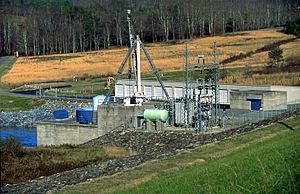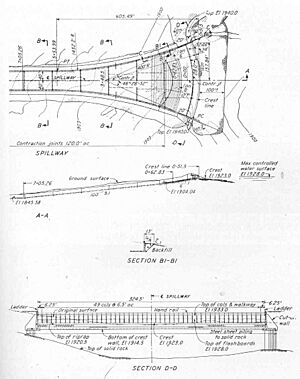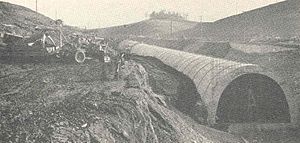Chatuge Dam facts for kids
Quick facts for kids Chatuge Dam |
|
|---|---|
 |
|
| Official name | Chatuge Dam |
| Location | Clay County, North Carolina, United States |
| Coordinates | 35°1′3″N 83°47′28″W / 35.01750°N 83.79111°W |
| Construction began | July 17, 1941 |
| Opening date | February 12, 1942 |
| Operator(s) | Tennessee Valley Authority |
| Dam and spillways | |
| Impounds | Hiwassee River |
| Height | 144 ft (44 m) |
| Length | 2,850 ft (870 m) |
| Reservoir | |
| Creates | Chatuge Lake |
The Chatuge Dam is a large dam on the Hiwassee River in Clay County, North Carolina. It helps control floods and also makes electricity. This dam is the highest of three dams on the river. The Tennessee Valley Authority (TVA) built it in the early 1940s.
The main goal was to store water and control its flow. This helped manage the water for the Hiwassee Dam further downstream. The dam creates Chatuge Lake, which is about 7,000 acres big. This lake sits right on the border between North Carolina and Georgia.
Even though it was first built for flood control, a generator was added in the 1950s. This allows Chatuge Dam to produce a small amount of hydroelectric power. In 2017, the dam and its related structures were added to the National Register of Historic Places.
The name "Chatuge" comes from an old Cherokee village. This village was once located near where the dam stands today.
Where is Chatuge Dam Located?
Chatuge Dam is about 121 miles (195 km) up the Hiwassee River from where it joins another river. It is just north of the North Carolina-Georgia state line. Chatuge Lake stretches south for about 13 miles (21 km) along the Hiwassee River. It also goes east for about 6 miles (10 km) along Shooting Creek.
The dam and the North Carolina part of the lake are surrounded by the Nantahala National Forest. The Georgia part of the lake is in the Chattahoochee National Forest. The closest towns are Hayesville, North Carolina to the north and Hiawassee, Georgia to the south.
How Big is Chatuge Dam?
Chatuge Dam is made of earth and rock. It stands 144 feet (44 meters) tall and is 2,850 feet (869 meters) long. It can produce 10,000 kilowatts of electricity. The dam has a special concrete overflow section called a "ski-jump" spillway. This spillway has 50 openings that can release a lot of water.
Chatuge Lake can hold a huge amount of water. It has a shoreline that is about 132 miles (212 km) long. Water flows through the dam using an intake tower. This tower is connected to the dam by a small bridge. From there, a steel pipe carries the water under the dam and releases it downstream.
Why Was Chatuge Dam Built?
People realized the Hiwassee River could be used to make electricity in the early 1900s. However, most plans focused on areas further down the river. In the 1930s, the Tennessee Valley Authority (TVA) took over flood control in the valley. They built the Hiwassee Dam and studied the river carefully. They found the Chatuge site was perfect for a new dam.
When World War II started in Europe, there was a sudden need for more electricity. This power was mainly for making aluminum in East Tennessee. The TVA offered to help by building several new dams. These dams would be on the Hiwassee River and other rivers that flow into the Tennessee River.
The Chatuge Dam project, first called the Hayesville project, was approved on July 16, 1941. Work on the dam began the very next day.
Building Chatuge Dam and its lake meant buying a lot of land. About 11,641 acres (4,711 ha) of land had to be bought. Over 1,900 acres (769 ha) of that land needed to be cleared. Many families, graves, and roads had to be moved. This included part of U.S. Route 64.
The TVA designed the dam to be simple and used basic materials like earth and rock. This helped them finish the dam very quickly. They wanted the lake to fill up with the winter rains of 1941-1942. The dam was built with strong earth fill. Both sides were reinforced with riprap (loose stones). The spillway was the only main part of the dam that needed concrete.
Since the lake would fill slowly, it could create places for mosquitoes to breed. To prevent malaria outbreaks, many steps were taken to control mosquitoes.
Chatuge Dam was finished and its gates were closed on February 12, 1942. The entire project cost just over $9 million. For many years, Chatuge Dam worked with the nearby Nottely Dam. Both dams have a similar design. They helped control water flow at Hiwassee Dam, which is 45 miles (72 km) downstream. A small generator was added to Chatuge Dam in 1954 to produce electricity.



